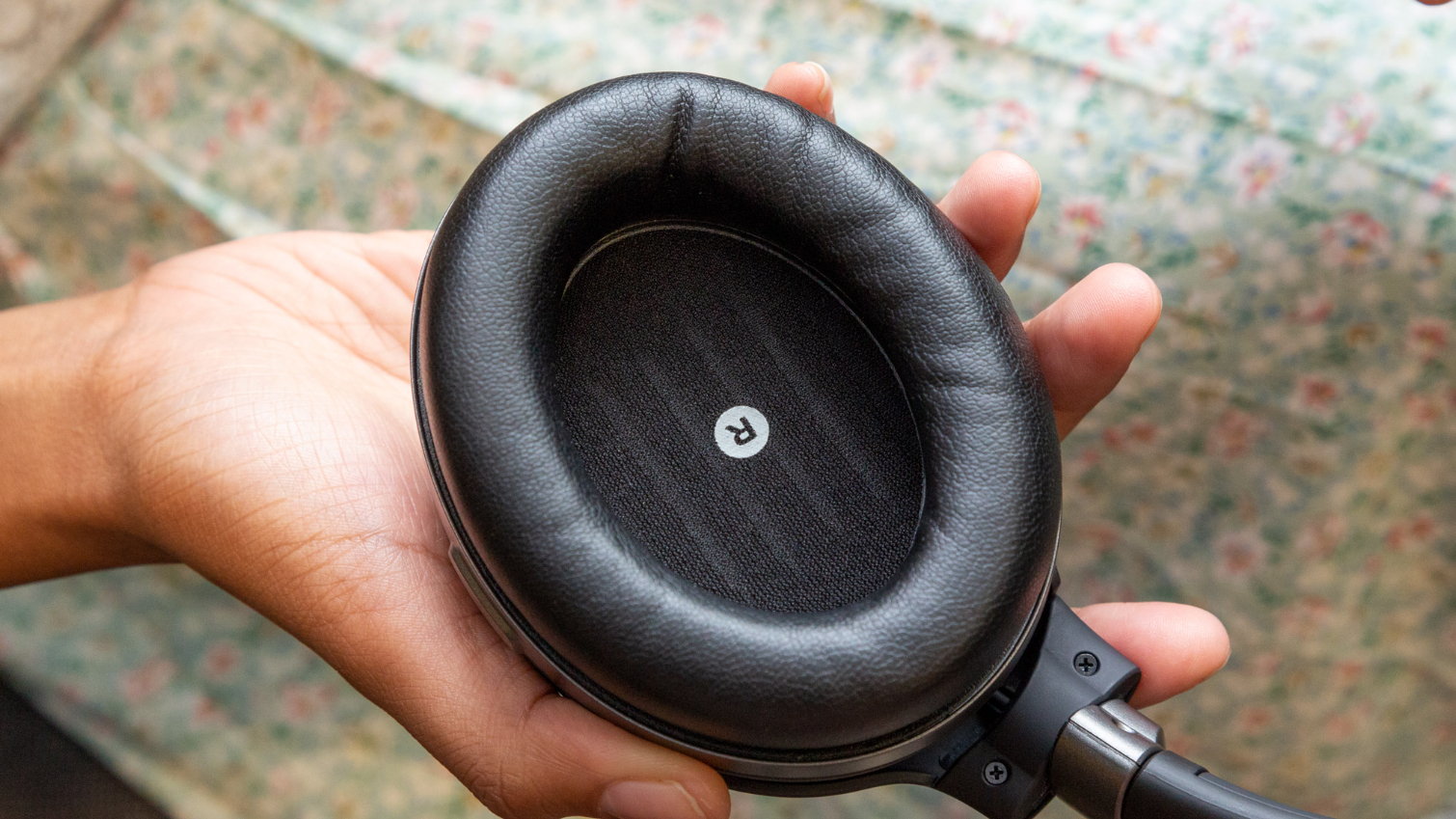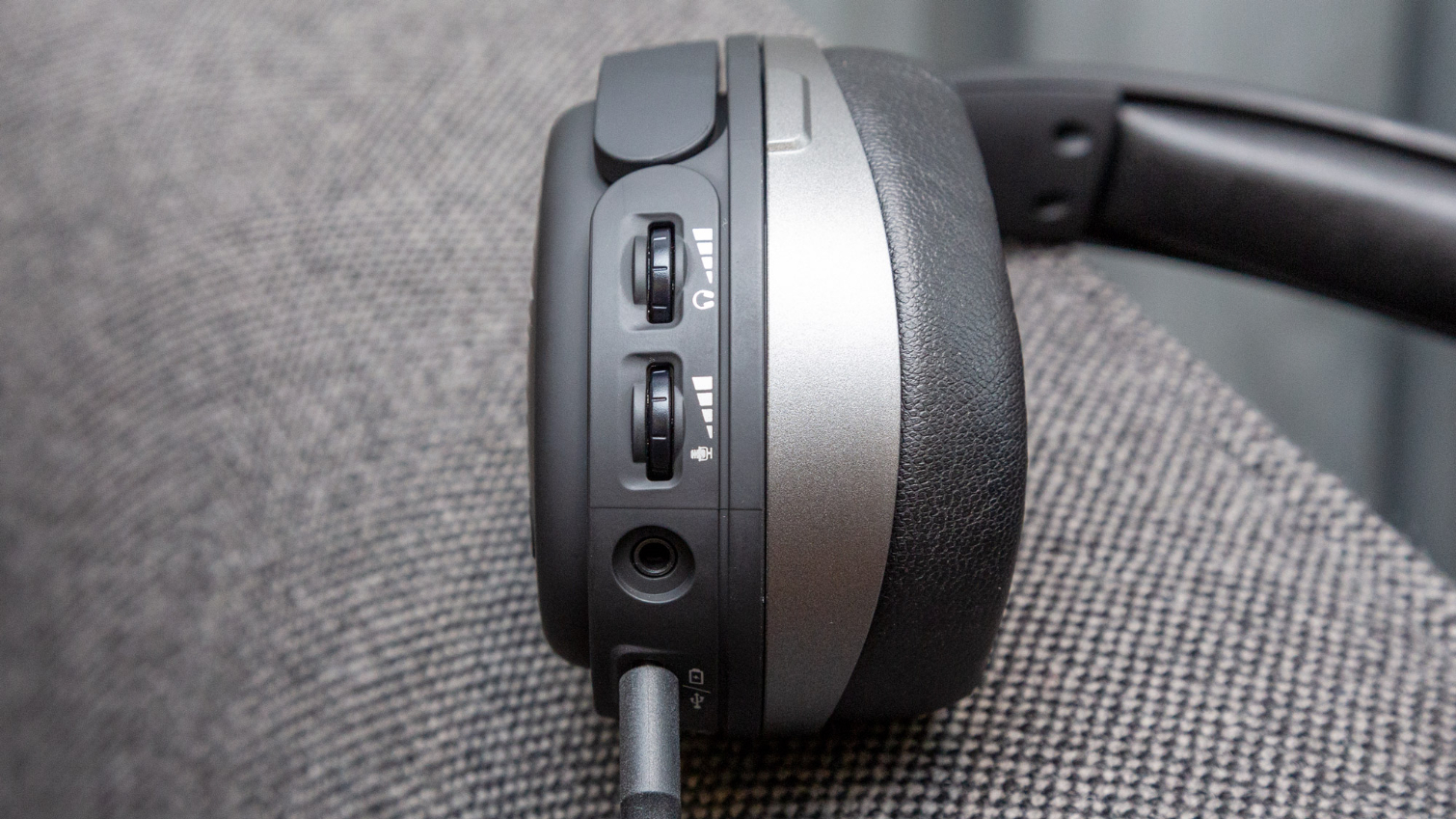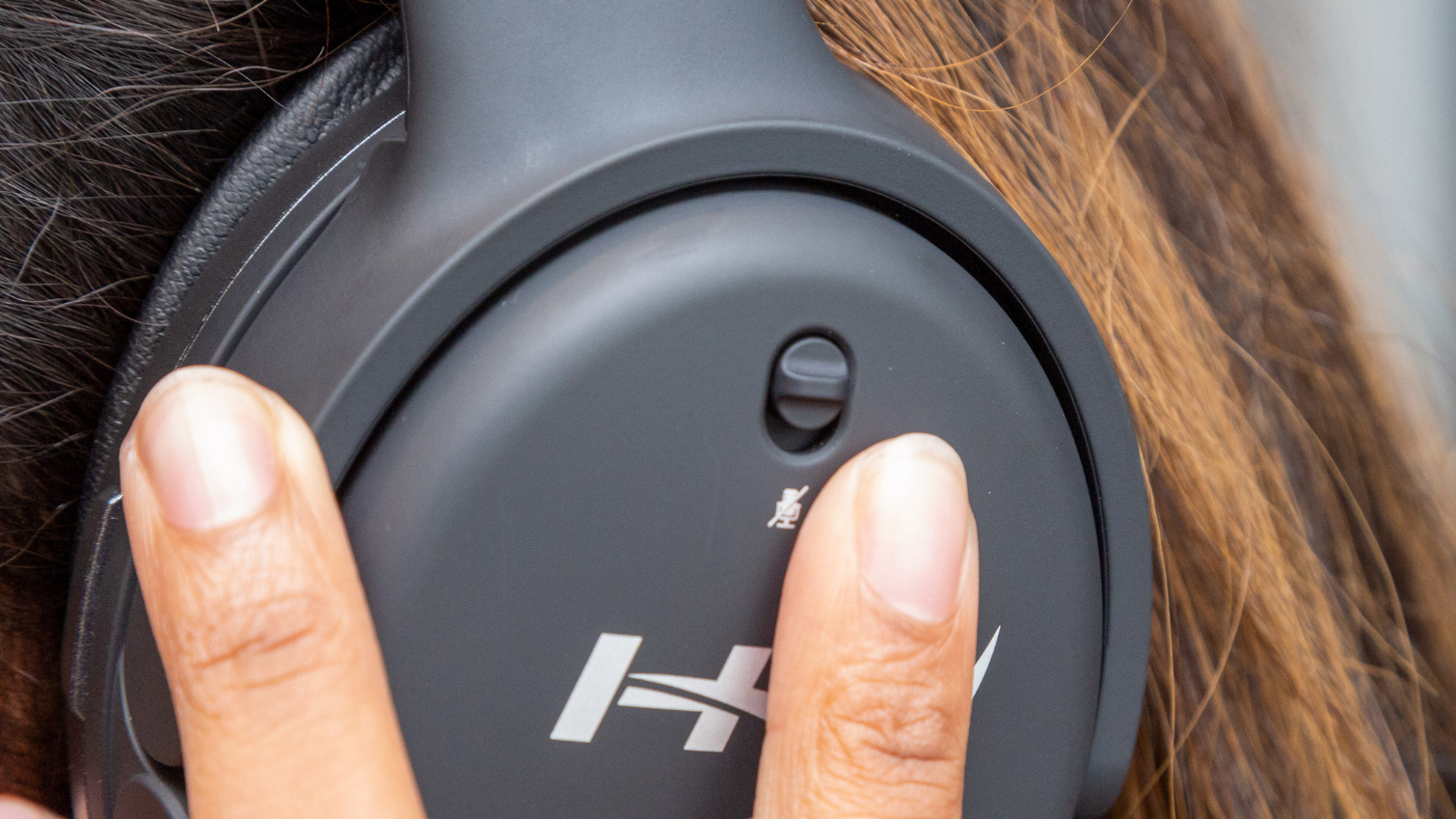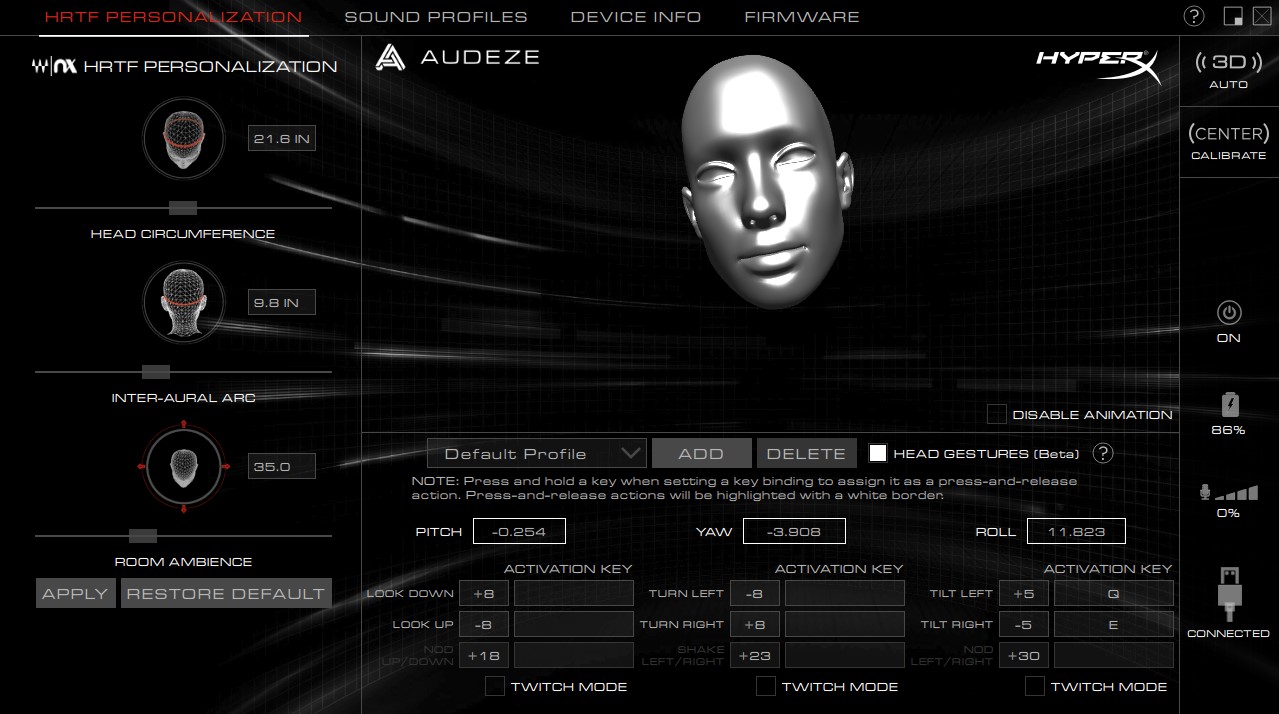Tom's Hardware Verdict
The HyperX Cloud Orbit S makes games and music sound like they’re filling the room. The headset can be an asset in gaming, but the head tracking feature is more noticeable in some games than others.
Pros
- +
Immersive and loud 3D audio
- +
Soft, squishy headband and ear cups
- +
Clear mic
- +
Good battery life
- +
Accurate head tracking
Cons
- -
A little heavy
- -
Head tracking’s audio impact varies depending on game
- -
Expensive
Why you can trust Tom's Hardware
The HyperX Cloud Orbit S is expensive for a wired gaming headset ($329.99), but you’re paying for premium hardware that delivers immersive audio that’ll fool you into thinking it’s playing out loud. With 3D audio modes amplified by head tracking, games and music feel like they’re filling the room with audiophile-quality sound with you as the focal point.
However, for much less money, you can get a true surround sound headset (rather than virtual) or a wireless one that’s more lightweight for on-the-go use.
HyperX Cloud Orbit S Specs
| Driver Type | 100mm planar transducer |
| Impedance | Not disclosed |
| Frequency Response | 10–50,000Hz |
| Design Style | Circumaural, closed back |
| Microphone Type | Unidirectional electret condenser |
| Connectivity | 3.5mm, USB Type-A, USB Type-C |
| Weight | 0.8 pounds (368g) |
| Cord Length | 3.5mm: 3.9 feet (1.2m)USB Type-A: 9.8 feet (3m)USB Type-C: 4.9 feet (1.5m) |
| Software | HyperX Orbit |
| Warranty | 1 year |
The Cloud Orbit S is virtually identical to the Audeze Mobius in design and features ($400) but without Bluetooth, a longer USB Type-A to Type-C cable (3m versus 1.5m) and a pop filter. It uses Audeze-brand planar magnetic drivers, so instead of using a magnet and a coil, like dynamic drivers do, they use a bendable piece of film/diaphragm with thin wires passing through it and magnets on either side. Current goes through those wires, making the diaphragm magnetic and allowing the magnets to move the film to make sound. Planar magnetic drivers are supposed to have less distortion than dynamic drivers.
On top of that, these drivers are large, with a diameter of 100mm. Generally speaking, the larger the driver size, the louder the sound. Most quality gaming headsets’ drivers are in the 40-50mm range, so obviously HyperX is going big and loud here. Frequency is wide as well (10–50,000Hz, compared to the $130 Logitech G Pro X’s 20-20,000Hz), suggesting strong output of the lowest lows and the highest of highs.
The Cloud Orbit S is compatible with PC and smartphones via USB (Type-C or Type-A). With the 3.5mm cable it also works with Xbox One, PlayStation 4, Nintendo Switch and other devices with headphone jacks; however, it will be limited to 2-channel and hi-res audio modes (no 7.1 surround).
Design and Comfort
The Cloud Orbit S has a sophisticated design that fits its price tag. It’s a gaming headset but, at least in terms of appearance, has the makings of professional gear. Its black-and-gray design yields a muted yet classic look that’s great for every day, whether you’re out in public or locked in your gaming dungeon. With its wider shape, it gave my head a Rosie from The Jetsons sort of shape, so it won’t be mistaken for a trendy pair of Beats or Bose cans, but it was passable on my New York City commute.





The contoured memory foam headband and ear cups are both made of artificial leather. They’re plump, squishy and soft and didn’t make me overheat, even after hours of use. Adjustments are also easy, with the headband’s clicking and the ear cups’ ability to tilt inward and swivel outward.
Get Tom's Hardware's best news and in-depth reviews, straight to your inbox.
The outside of the ear cups and headband are velvety, matte pieces with a quality feel. All three carry some form of HyperX branding and may be subject to some minor fingerprints. There’s a scratch-resistant coating on the inside, so the Audeze and Waves NX logos can stay intact long-term.
At 0.8 pounds (368g), the Cloud Orbit S is slightly lighter than the Sennheiser GSP 670 (0.9 pounds) but heavier than the HyperX Cloud Alpha (0.7 pounds) and equal to the SteelSeries Arctis 7 2019 Edition wireless headset. Still, the headset felt a bit weighted and wide in my time with it. While the cozy feel of the memory foam headband against my skull prevented the headset from hurting me, it still felt weighed down, sliding lower than I’d prefer. If only I could make things a bit tighter somehow.
All of the headset’s controls and ports live on the left ear cup. There’s a 3D button for activating and recalibrating the headset’s 3D mode (more on that in the next section) and a port for the removable microphone. Next to that is a USB-C port for charging with one of the two included cables, a 3.5mm port for attaching the 4-pole 3.5mm cable (for when you want to use it with a smartphone, PS4, Xbox One or Switch). The headset and mic volume wheels don’t have a stopping point, but you’ll hear a beep when trying to go past mid/max volume. The microphone volume wheel next to it also lets you change your audio mode (7.1 channel, 2 channel or hi-res) by pressing down for three seconds or the EQ preset if you press down and scroll. You can prevent the headset from charging when connected via USB (and save the connected device’s battery) by holding down the headphone volume wheel for three seconds.
If that sounds like a lot for one cup, HyperX labels most of the controls. The only ones you have to remember on your own is that the volume wheel is how you stop charging and the mic wheel is how you change the audio mode. That's unfortunate considering there’s no way to do either of these things via software currently, but HyperX told me that will be changed in a future update.
On the other hand, the headset offers handy clues to let you know what’s going on, with a female voice robotically saying things like “on,” “aux,” when you plug attach the 3.5mm cable or “USB” when you unplug it. And you can tell if the Cloud Orbit S is on by the left cup’s LED light, which flashes blue when the headset’s on, red when it’s charging and off when fully charged.
Audio Performance: Gaming
The Cloud Orbit S looks expensive on the outside, but you’re primarily paying for what’s on the inside and the remarkable audio quality that comes out.
The headset has hi-res, 2 channel and -- if you’re connected via USB -- 7.1 surround modes. If you’re in 7.1 or 2 channel mode, you can enable 3D audio, which enhances the surround sound effect, especially with head tracking enabled.
When gaming, 3D audio has quite an impact. It works using a Waves NX-brand sound processing card to improve the accuracy of the position of sounds by emulating “three dimensions” of audio localization, according to HyperX. The Cloud Orbit S (unlike the $299 HyperX Cloud Orbit) can amplify this effect with head tracking, supposedly at 1,000 times a second. So it can make an environment that moves with you, enhancing your gaming skills by letting you tell, for example, where exactly a shooter is lurking.
You get your choice of three different 3D Modes, which you change by holding the 3D button down for three seconds:
- 3D On: 3D audio without head tracking
- 3D Automatic: 3D audio and head tracking, but the center point is automatically set as your head moves
- 3D Manual: 3D audio and head tracking, and you set a center point by pressing the 3D button once.
I played Doom on a PC with 7.1 audio and 3D mode with head tracking. Immediately I could tell the difference. The noises of creatures gargling and the bursting pipes of a space station felt like they were all around me. I could tell they were ahead and to the left, based on the audio. At another part of the level, I knew to wait before entering a hallway because I could hear an out-of-sight demon prepping a fireball over on the right. During questionable usage of a rocket launcher, I heard a powerful boom followed by echoes that sounded like they were moving further away and outward.
Similarly, when I played Fallout 4, I could tell that a machine gun turret was behind me, letting me spot it and destroy it before it hurt me.
When I deactivated 3D mode in either game, the audio instantly sounded less clear and immersive.
However, when I toggled the 3D audio’s head tracking on and off in Doom, I couldn’t tell an immediate difference. In Fallout 4, the head tracking made had more noticeable effect, making my auricular environment move with me. As I continuously fired my shotgun and turned my head from left to right, I heard the shots more prominently in the forward-facing ear but not in an unnatural or disturbing way. The effect was smooth and made the game feel more realistic. This wasn’t the case when 3D mode was on without head tracking.
The helpfulness of this is debatable. No, you’re not necessarily moving your head around aggressively when gaming. But there are subtle movements you may make subconsciously and the Cloud Orbit S adds a level of reality to those scenarios that you didn’t know you missed but will quickly know you did. While the head tracking wasn’t so apparent to me when playing Doom, it was in Fallout 4, where it was definitely an enhancement to the overall sound quality and made the game more realistic.
However, the head tracking feature can also be used to program key functions via head gestures. It worked well when I made a left head tilt equal to pressing “D” or a right head turn to “Q.” In a fast-paced game where every split second decision counts, being able to tilt your head may be easier than pressing buttons. Or you can just use it as another form of input in addition to your hands. For example, in Middle-earth: Shadow of War, I made a left head tilt equivalent to pressing “W” for walking forward and used my fingers for focusing on running attacks.
The feature could also be useful for people with limited mobility, allowing them to control things by moving their head. You can program head gestures -- left or right head turn or tilt or looking up or down -- in the HyperX Orbit software (more on this in Software and Features). However, the software has to be open to use head gestures, Note, though, that feature was in beta when I reviewed this headset.
For console players, the Cloud Orbit S is still an asset, even though it can only operate in stereo mode. With 3D audio and head tracking activated, game audio still seemed like it was playing out loud and felt more enveloping (especially when moving my head) than before.
Audio Performance: Music
Headsets can make you feel isolated, but the Cloud Orbit S can trick you into thinking sound is all around you, which is a delight when listening to music. Both on the subway and in my office I had moments of fear, thinking my music was accidentally playing out loud, and resisting the urge to dance in public was harder than usual.
With 7.1 surround sound and 3D audio off, mediums were clear and crisp as was treble, even at low volumes. Meanwhile, bass was consistently strong without being over the top or creating a popping noise, like you might notice in low-quality headphones. And they get seriously loud, more than ample to cover up any background noise, including that of a noisy subway station. Just note your neighbors because at around 65% volume, those near me could hear my music.
Adding 3D noticeably enhanced the surround sound feeling by making the audio more full and powerful. Bass in Daft Punk’s “One More Time” was strong and commanding, and I even noticed a high-pitched treble beat in the background that I hadn’t before.
When I added 3D mode’s head tracking, I didn’t notice a difference until I started moving my head and the music moved with me, similarly to how it would sound if I turned my head toward a speaker. As I turned my head from left to right, there was a second where I could feel the audio shifting, which was something I didn’t notice strongly when gaming.
The Cloud Orbit S looks good enough to take on the go, but is limited to stereo channel when using the 3.5mm cable with smartphones. This isn’t a problem if you have a phone with a USB-C port, but with an iPhone SE I wished I could make things louder, especially when I walked past a jackhammer that I could hear over my jams. But since 3D modes and head tracking still worked, the surround sound effect was still present.
Voice Chat
For shouting at your virtual enemies, strategizing with your teammates, dialing into a work meeting or just chatting with Mom (have you called yours lately?), the Cloud Orbit S has a detachable microphone. Many gaming headsets have this, but the Cloud Orbit S’ mic is also unidirectional, so it only picks up noise from one side and has noise cancellation and a pop filter, for fighting the popping sound made by sounds like b or p. I did a video call with someone wearing the headset, and his voice was clear as day. With music playing in their background, I could still hear his voice on top, and when he was silent, I could hear the music quietly as well. Phrases filled with potential for pop -- like “The bees baked the peas” -- came out smoothly and without any loud popping noises or distortion.
Voices also came in clear and warm during a video conference with my Tom’s Hardware colleagues. At max volume, there was no distortion or popping from my colleagues’ excitedly discussing their day’s itinerary. Even at low volume, one fellow editor sounded like he was in the room with me, despite being halfway across the country. I was also able to remove the echoing coming from another editor speaking from his living room, by tweaking the inter-aural arc in the headset’s software.
Battery Life
To use the HyperX with a PC, you have to connect to a Type-A or Type-C port, which will also charge the headset (unless you disable this). This means in typical usage, the headset was usually charging without me noticing, and I never had to go out of my way to charge it.
For other situations, like when plugged into a PS4 or Xbox One controller or smartphone’s headphone jack or if you just don’t want your device to charge the headset, HyperX claims the Cloud Orbit S lasts for 10 hours at 50% volume. During my time with the headset, which included using it with a PC (with charging disabled), controller and smartphone at varying volumes, the headset lasted about 15.5 hours.
Features and Software
The headset’s free software, HyperX Orbit, is virtually identical to that of the Audeze Mobius.
It has a panel for HRTF (head related transfer function) adjustments, which lets you adjust 3D sound to fit you. The inter-aural arc is meant to match the distance from one ear canal to the other, going from around the back of the head. The room ambiance slider adjusts reverb in 3D modes. As mentioned, playing around with the inter-aural arc and room ambiance sliders made noticeable differences, so it’s worth getting these right; they’re not just for show.
The right side lets you quickly toggle between 3D modes and re-calibrate for head tracking. Underneath, you’ll see info about your headset if it’s plugged in. Unfortunately, there’s no way to see or switch your audio mode (7.1, hi-res or 2 channel) through the software. At the time of writing, this can only be done by holding down the microphone volume wheel. However, HyperX told me the company will add a toggle to the software in a future update.
That creepy head in the middle moves with yours to demonstrate the head tracking and works accurately in real-time. The software lets you easily program head gestures, by using pitch, yaw and roll sensor values. You can attach gestures, based on the amount of movement in degrees, to alphanumeric characters, Shift, Alt, Ctrl, F1-F12 and top row numbers. Twitch mode lets you make a gesture for nodding up/down, shaking left/right or nodding left/right.
The software also gives you access to seven sound profiles (Default, Flat, Footsteps, Ballistics, Music, Racing, RPG and Warm), but you can’t tweak them. Meanwhile, the Device Info section gives you an overview of the headsets layout, and there’s also a section for downloading the latest firmware.
Accessories and Configurations
Each Cloud Orbit S headset comes with a detachable mic, plus three cables (braided USB-C to USB Type-A, USB-C to USB-C and 3.5mm) and a simple, black, drawstring HyperX pouch. The headset only comes in one color.
HyperX also has the Cloud Orbit headset, which is $30 cheaper but doesn’t have head tracking.
Bottom Line
The HyperX Cloud Orbit S delivers beautiful, premium audio, thanks to its 3D modes with head tracking that make you feel like the room filled with sound. Gamers will enjoy long gaming sessions, thanks to the crisp, clear audio at all volumes and modes. 3D audio enhances immersion to the degree that you can tell the direction of an incoming enemy. Head tracking amplifies this and can even be used for gaming input, freeing up your hands for other mischief.
To save $30, you can opt for the HyperX Cloud Orbit, but it lacks head tracking. If you don’t move your head a lot or aren’t the most competitive gamer seeking every level of advantage, including the most detailed audio, you can probably live without head tracking. Meanwhile, you can get a true 7.1 surround sound headset in the Asus Strix 7.1 for less than the Cloud Orbit S ($170) or even a premium wireless gaming headset, the Sennheiser GSP 670, for a little more ($350).
But for a new level of top-of-the-line virtual surround sound and 3D audio with a boost in gaming, you’ll need the Cloud Orbit S and its impactful head tracking.
Image Credits: Tom's Hardware
MORE: All Gaming Headset Content

Scharon Harding has over a decade of experience reporting on technology with a special affinity for gaming peripherals (especially monitors), laptops, and virtual reality. Previously, she covered business technology, including hardware, software, cyber security, cloud, and other IT happenings, at Channelnomics, with bylines at CRN UK.



